Local Food Newsletter – September
go.ncsu.edu/readext?620019
en Español / em Português
El inglés es el idioma de control de esta página. En la medida en que haya algún conflicto entre la traducción al inglés y la traducción, el inglés prevalece.
Al hacer clic en el enlace de traducción se activa un servicio de traducción gratuito para convertir la página al español. Al igual que con cualquier traducción por Internet, la conversión no es sensible al contexto y puede que no traduzca el texto en su significado original. NC State Extension no garantiza la exactitud del texto traducido. Por favor, tenga en cuenta que algunas aplicaciones y/o servicios pueden no funcionar como se espera cuando se traducen.
Português
Inglês é o idioma de controle desta página. Na medida que haja algum conflito entre o texto original em Inglês e a tradução, o Inglês prevalece.
Ao clicar no link de tradução, um serviço gratuito de tradução será ativado para converter a página para o Português. Como em qualquer tradução pela internet, a conversão não é sensivel ao contexto e pode não ocorrer a tradução para o significado orginal. O serviço de Extensão da Carolina do Norte (NC State Extension) não garante a exatidão do texto traduzido. Por favor, observe que algumas funções ou serviços podem não funcionar como esperado após a tradução.
English
English is the controlling language of this page. To the extent there is any conflict between the English text and the translation, English controls.
Clicking on the translation link activates a free translation service to convert the page to Spanish. As with any Internet translation, the conversion is not context-sensitive and may not translate the text to its original meaning. NC State Extension does not guarantee the accuracy of the translated text. Please note that some applications and/or services may not function as expected when translated.
Collapse ▲Welcome to the N.C. Cooperative Extension, Currituck County Center Local Foods Newsletter! This month’s edition will be focused on Muscadine grapes. Enclosed you will find fun facts on Muscadine grapes including: the history of Muscadine grapes, trellis information, planting tips, proper pruning, nutritional information, tasty recipes, and more! This newsletter also includes an interactive map that is linked to Google maps. Users can click on their desired local foods operation and be given directions to the business. Following the map is a quick-reference table containing the local businesses in the area that sell local Muscadine grapes and grape products. Don’t forget to check out our upcoming local food class for cooking and gardening with container greens! For email reminders of future Local Foods newsletters, fill out this short form.
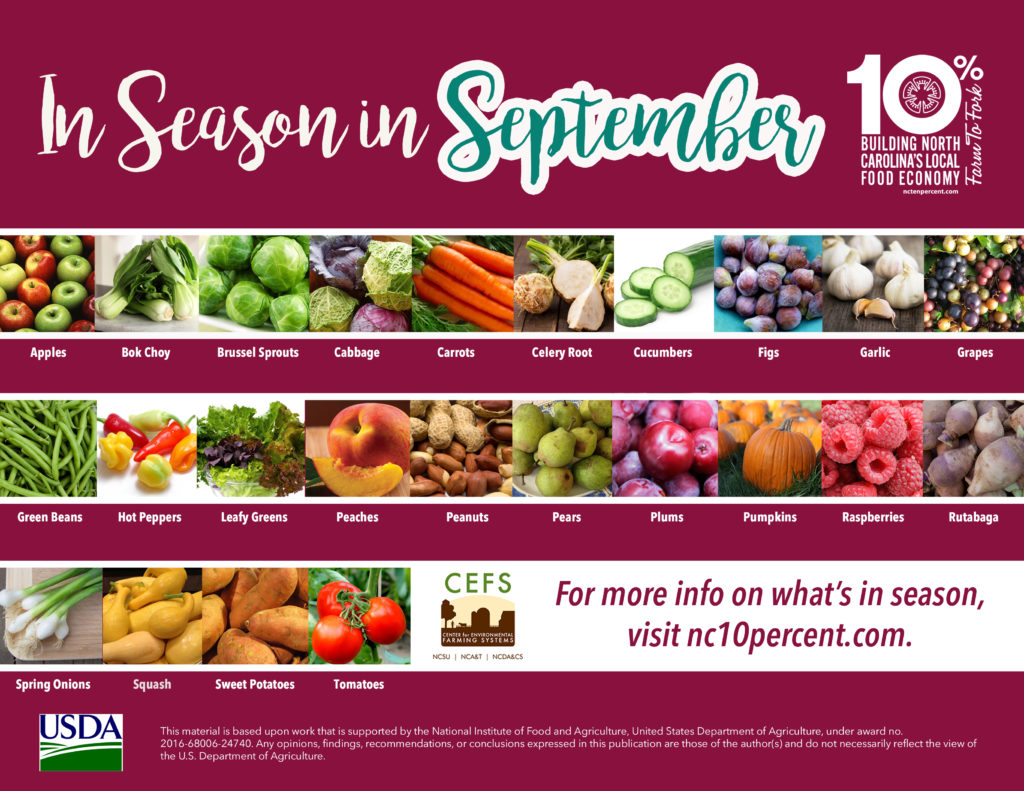
Food Highlight
Fun Fact. This month’s highlighted local food is Muscadine grapes. Muscadine grapes are often referred to as “Scuppernongs”, after the area in which they were found. The first recognized muscadine cultivar was bronze in color and was found before the 1760s by Isaac Alexander in Tyrrell County, NC. It was first known as the ‘Big White Grape’, and was later named ‘Scuppernong’. With time, the name scuppernong became generic with all bronze muscadines, regardless of the actual variety name. However, this is incorrect nomenclature, since ‘Scuppernong’ is only one of many cultivars of muscadine grapes.
Muscadine grapes are native to the Southeastern United States and have been cultured for more than 400 years. Native Americans preserved muscadines as dried fruit long before the Europeans inhabited this continent. As early as 1565, Captain John Hawkins reported that the Spanish settlements in Florida made large quantities of muscadine wine. For much of the history of the crop, varieties were simply selections from the wild.
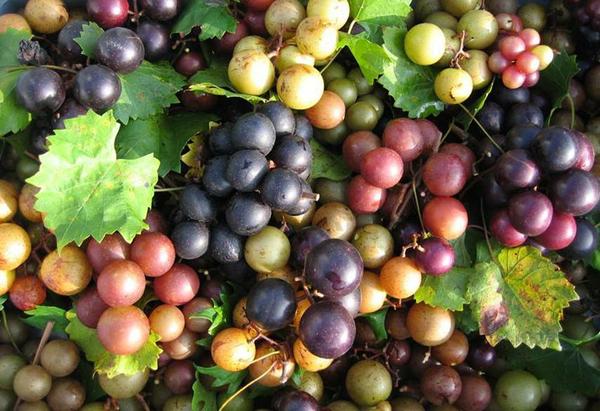
Trellis. Before planting, Muscadine grapes should be trellised. Many types of trellising have been used successfully, but an equal number have been designed that have not been practical for long-term management of vines. A practical system allows for establishing permanent cordons (arms) that can be easily reached for the required annual pruning (Image below). This requires training of the cordons to single strands of wire (No. 9 is recommended). A single wire 5 to 6 feet above the ground and well anchored on each end is the easiest trellis to construct and maintain. For a double wire system, four-foot cross arms of 2 x 6 inches, treated lumber, can be attached to treated posts to support double wires. A double-wire system will yield about 30% more than the single-wire system.
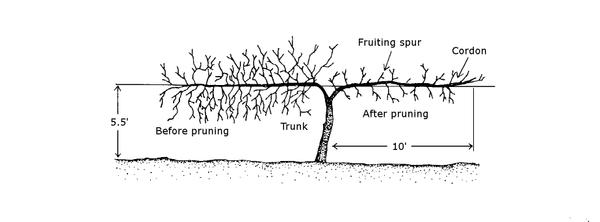
Planting. Vines should be planted when there is little chance of sub-freezing temperatures in the spring. Potted plants are easier to hold until the proper planting time, but bare-root plants are satisfactory if the roots are kept moist (not wet), and the plants are refrigerated until planting time. Plant at the same depth or slightly deeper than the previous planting depth. Vines should be a minimum of 10 feet apart in the row, but more desirably, 20 feet apart. Distance between rows can depend on the equipment used for mowing, but 8 feet should be a minimum.
Pruning. After planting, prune to one stem and cut this stem back to 2 or 3 buds. When new growth begins, select the most vigorous shoot and cut away the others. A bamboo-training stake beside the plant is convenient for attaching the growing vine. Loosely tie the shoot to the stake. Paper-covered wire ties that are wrapped around the vine and stake work well but to avoid girdling, do not twist the ties. Continue tying the vine each week and removing side shoots. When the vine is just below the wire, cut the growing tip to force lateral buds. Shoots from the lateral buds should be trained down the wire to form the cordons, just as the trunk was trained up the stake. The goal should be to get the vine on the wire the first growing season and to full length in the second season. After the cordon has developed to full length, side shoots can be allowed to develop. These side shoots should be cut back to 2 or 3 buds during the dormant season. The next season, the buds on these side shoots will develop into shoots that produce flowers and fruit (before and after image below). Each dormant season, the lateral shoots must be cut back to 2 or 3 buds by hand or with a hedge trimmer.
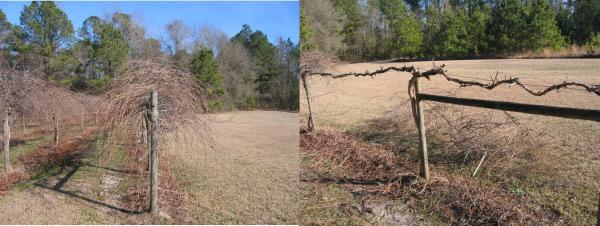
Cooking Spotlight
Nutritional information. Muscadines are a good source of fiber and rich in manganese. They are beneficial for digestion, bone production, skin health, blood sugar control, and preventing oxidative damage to cells. They are also among the richest fruits in antioxidants, which makes them a great snack for kids and adults. You can eat the entire fruit, however, some people prefer to squeeze the skin and pop the pulp into their mouth as well as spitting out the seeds. Others eat the whole berry- skins, seeds, and pulp. Try different varieties of muscadine and different ways of eating them to see which you prefer.
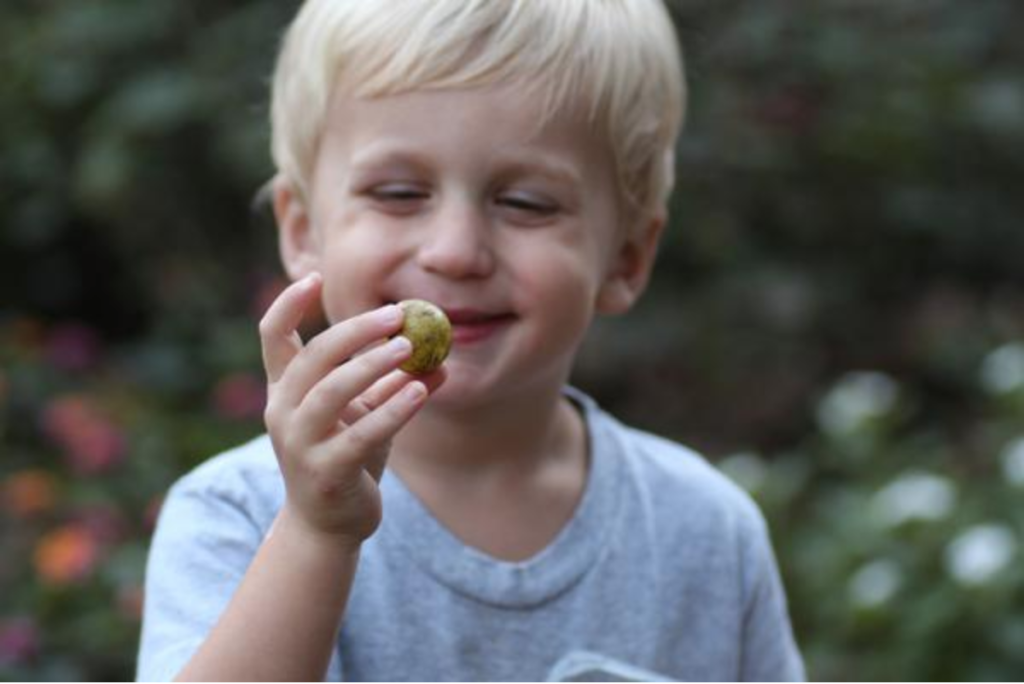
Muscadine Smoothies and Popsicles
Muscadines have thick, fleshy skins, and most cultivars have seeds. The whole fruit provides the most nutrition and can be delicious if all of it is used. If a high-powered blender is available, use the entire fruit; otherwise, use the pulp mixture that has been cooked and run it through the food mill. Popsicles can just be frozen smoothies, so the recipes below can be used for either liquid or frozen treats! Add all of the ingredients to the blender, mix, and enjoy!
|
Summer Smiles 1 quart of muscadine grapes 1 pint of North Carolina blackberries 2 North Carolina peeled peaches 1 peeled banana |
Awesome Sauce 1 quart of muscadine grapes 3 sliced apples 2 celery stalks 1 cup of plain yogurt Honey to taste |
|
Happy Dance 1 quart of muscadine grapes 1 cup chopped melon 1⁄4 cup mint leaves Lime juice to taste (1 to 3 tablespoons) Honey to taste |
Upcoming Local Foods Event
Join us for one of our local foods cooking and gardening classes. Registration is now available on our website so go ahead and reserve the date on your calendar.
Cooking and Gardening with Container Greens
Do you love eating greens picked fresh from the garden? Got a bumper crop of them and don’t know what to do? Well, this is the class for you! The N.C. Cooperative Extension, Currituck County Center is having a “Gardening and Cooking with Container Greens” class on Wednesday, September 11, 2019, from 10 a.m. to 1 p.m. Registration and a class fee of $20.00 are required.
This interactive map contains many of the businesses in Currituck that sell local produce. To view the map legend, click the small square box at the left of the map name. This should bring up a list of the direct sale markets, pick-your-own operations, roadside markets, vineyards and breweries, and N.C. seafood operations on the left. You can then click on the pins on the map or on the legend to view each local business. Each listing will contain a contact number, operating season and hours, and produce the business sells. If you click the View in Google Maps option below the description you will be given directions to the business from your current location.
Highlighted Businesses
The highlighted business section shows the businesses that sell the month’s highlighted local food. This month we have eight businesses that will be open and selling Muscadine grapes or grape products. Information on those businesses can be found in the table below, or in the interactive map above.
| Name | Phone | Hours | Address |
| Soundside U-Pick Grapes | None | M-Su, 8 a.m.–sunset | 706 Poplar Branch Rd, Grandy |
| Martin Farm and Winery | (252) 429-3564 | Vary please call | 213 Martin Farm Ln, Knotts Island |
| Seaside Farm Market | (252) 619-8285 | M-Su, 8 a.m.–8 p.m. | 787 Sunset Blvd., Corolla |
| Tar Heel Produce | (252) 491-8600 | 7 a.m.–6 p.m. | 6954 Caratoke Hwy, Grandy |
| Powell’s Roadside Market | (252) 339-9923 | 7 a.m.–8 p.m. | 2138 Caratoke Hwy, Moyock |
| Grandy Greenhouse & Farm Market | (252) 453-2658 | 8 a.m.–5:30 p.m. | 6264 Caratoke Hwy, Grandy |
| Morris Farm Market | (252) 453-2837 | 9 a.m.–6 p.m. | 3784 Caratoke Hwy, Maple |
| Sanctuary Vineyards | (252) 491-2387 | M-Su,10 a.m.–6 p.m. | 7005 Caratoke Hwy, Jarvisburg |
For email reminders of upcoming Local Foods newsletters, fill out this short form. If you have a local food operation you would like advertised in upcoming installments, please fill out our producer form or contact Adam Formella by email or phone at Adam_Formella@ncsu.edu or 252-232-2262.




